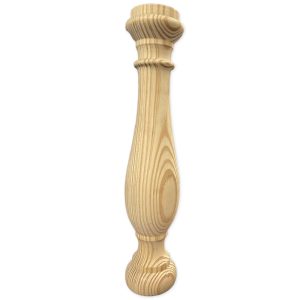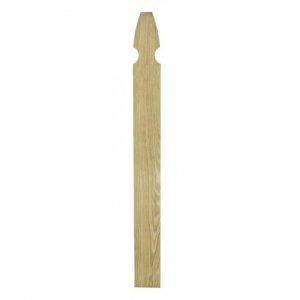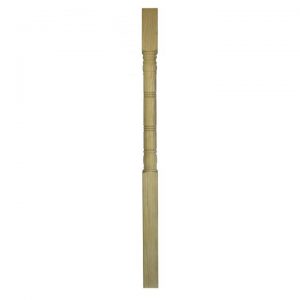Homeowners long for renovation projects that wisely recoup costs. Simple details like exterior wood balusters, galvanized nails, and pressure treated lumber that has been kiln-dried help to recoup a large amount of the project when proprietors go to sell. It’s time to make smart decisions on your next home investment. Spend money where it adds value while maximizing curb appeal.
According to Home Advisor, homeowners spend between $727 and $2,411 on deck repairs. The average recoup yields $1,526 in 2018.
Unfortunately, some builders don’t follow best practices, which can increase the amount of money a homeowner will need to spend to fix what should have been created correctly the first time. Decks decay quickly when proper outdoor materials aren’t used. Poor material and labor choices lead to instability, rotting, discoloration, broken boards, rot, termite damage, and slippery floors.
Great quality materials, on the other hand, save money, time, and maintenance. No one wants to deal with an expensive problem that could be prevented in the first place.
The secret is to use exterior grade products to ensure more than a decade of wear and tear.
Discover four options to improve your home’s resale value.
Invest in Proper Exterior Wood Balusters, KDAT Lumber, and Galvanized Fasteners
No deck wood is completely immune from rot, insects, and decay, just like no nail is exempt from rust; but exterior building products have greater longevity than interior ones. Howecer, pressure treated pine and western red cedar are excellent water-resistant lumber choices.
Treated lumber is a low maintenance option, but it lacks the same aesthetic appeal as cedar. It is a premium choice for locations with consistent weather and, because the pine is kiln dried after pressure treatment, it makes the wood less likely to warp.
Western red cedar, on the other hand, is known for its distinctive smell and rich color. It is best for above ground applications. The hardwood is great for people in extreme climates because the wood produces its own oils years after being pressed into lumber. This helps that keep the wood in good shape and is more visually appealing than pressure treated pine. Western red cedar will need diligent cleaning and resealing, or it may lose its rich color after a few years. The wood itself will withstand nearly 15 to 20 years, but it may deteriorate faster on ground floor and shaded areas.
Pressure treated wood is designed to withstand the elements because it is saturated with a copper rich preservative like Copper Azole (CA). This chemical, and others like it, help the wood resist fungus and microorganisms, but the Copper also reacts chemically with some nails. KDAT lumber offers greater fastener holding power when used with the right nails. So, be sure to use galvanized or stainless-steel fasteners on pressure treated wood. While all nails and fasteners are susceptible to rusting, galvanized hardware takes much longer to rust than other types.
It is important to use quality materials because maintaining a deck through the next decade costs significantly less than replacing one.
Refinish and Repair Your Wooden Deck with Exterior Products
Now that you know the basic materials, it’s time to make a smart decision for your home investment.
According to “Remodeling,” a construction magazine, the 2018 Cost vs. Value report advises refinishing a 10 x 12-foot deck with sealer paints or stains. This will cost between $350 to $750, but sealers preserve the wood’s look. Semi-transparent to semi-solid stains bring out wood grains and add a tint of color. Stains and sealers work on western red cedar and pressure treated pine when applied to dry wood.
If a deck is structurally intact, and the wood is healthy, only minor repairs may be needed.
Working with a handyman for minor repairs may save additional money; some contractors add up to 15 percent to the cost of materials as a handling fee. Save money by choosing your own materials. Larger contractors and architects may be a better option for remodeling a deck. A handyman will guide you to fix the deck by looking for instability, rotten wood (especially on ground contact areas like the frame), support posts, and stair stringers, discolorations, broken deck boards, deck rot, termite damage, and slippery spots. A handyman’s price will vary depending on whether the rail needs replaced, a trim rail, post end caps, exterior wood balusters or something else. The estimated labor costs may be $100 to $500 for labor plus a fee for mileage depending on the area being serviced, as well as the intricacy and quality of the previously used materials that need replaced. Some handymen price by the hour; some by the job. Some will insist on being paid when each milestone is complete.
The costs of repairing individual fixes like replacing busted exterior wood balusters or spindles, top and base trim, deck boards, and handraild, are significantly less than the cost of replacing an entire deck.
Wood Decks Recoup More Value Than Composite Decks

Refinishing or fixing a wood deck will recoup value more than composite decks. According to the 2018 Cost vs. Value report, home owners that choose wooden decks recoup 82.8 percent; as opposed to composite deck owners which recoup 63.6 percent. Consider updating the front porch by adding a 16 x 20-foot wooden deck. All parts from the exterior wood baluster to wood railings should be made from pressure treated lumber that is kiln dried to stay within the estimation. Assuming these materials are used, the average cost to construct the deck would be $10,950. This would add $9,065 to the resale value of the home. Pressure treated decks retain 82 percent of its value and can still be customized to account for individual preferences. For example, pressure treated floor decking can be installed in the following fashions:
- Angled board patterns
- ATX Pattern
- Chevron with transition board
- Deck with cross pattern
- Standard pattern
- Diagonal or double diagonal
- Herringbone
- Multiple patterns
- Nested square patterns
- Patchwork or basket weave pattern
- Picture frames
- Transition boards
- Wood patio tiles
Or exterior wood balusters can be installed in a Chippendale, Craftsman style, turned baluster, or sunbursts deck railing fashion.
Painting and Staining Wooden Exterior Decks
All treated lumber needs to be completely dry before it can be painted. All products from S&L Spindles come ready to paint or stain right out of the box. If painting appeals to you, consider adding color without the kitsch. Look at the existing colors on what you can’t change around your house like the brickwork, timber joinery, aluminum window framing, roof and driveway. These are large areas that impact color.
Many homes are improved with a simple black and white color scheme, or a dramatic monochromatic scheme, or even a pastel inspired pallet to give it a Hampton feel. Color choices may be down-to-earth, grey on grey, sunburned or all white with layered neutrals. The trick to picking a color scheme is to choose exterior grade paints that have greater longevity than interior paints and pick a timeless scheme. It will be costlier up front, but the hope is for the project to last for a decade.
It is advised to prime everything before it is assembled. Mold and decay will mount up quickly if you fail to use exterior grade products. Don’t sandwich moist pieces of wood together. Doing so holds water and causes decay. Use vertical gains, prime everything, and bevel rail caps so water sheds off on all sides. Stainless steel screws and pressure treated materials like exterior wood balusters, post caps and finials all done together in best practices, create a long-term quality wooden deck that stands the test of time.
By following the suggestions above, you can rest assured that you’ll recoup some costs on your next home improvement project.









